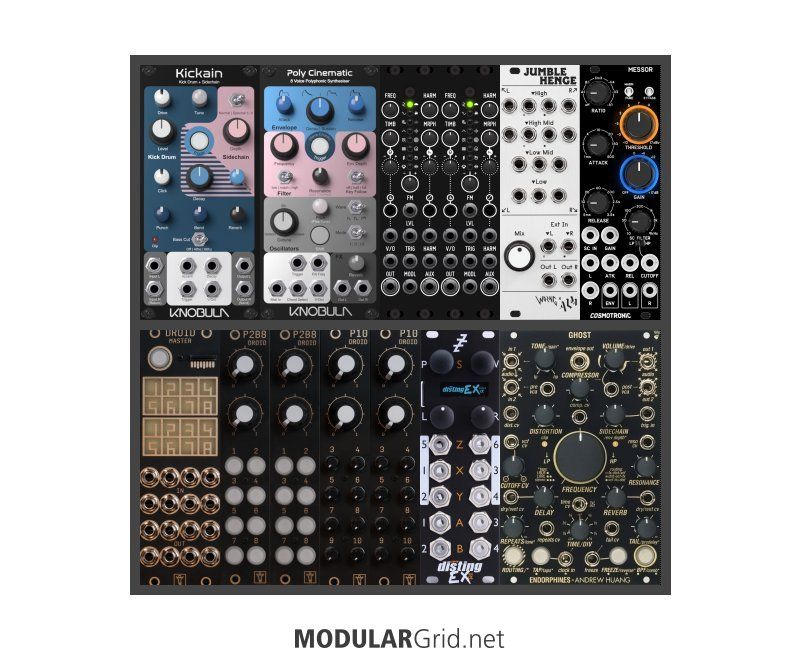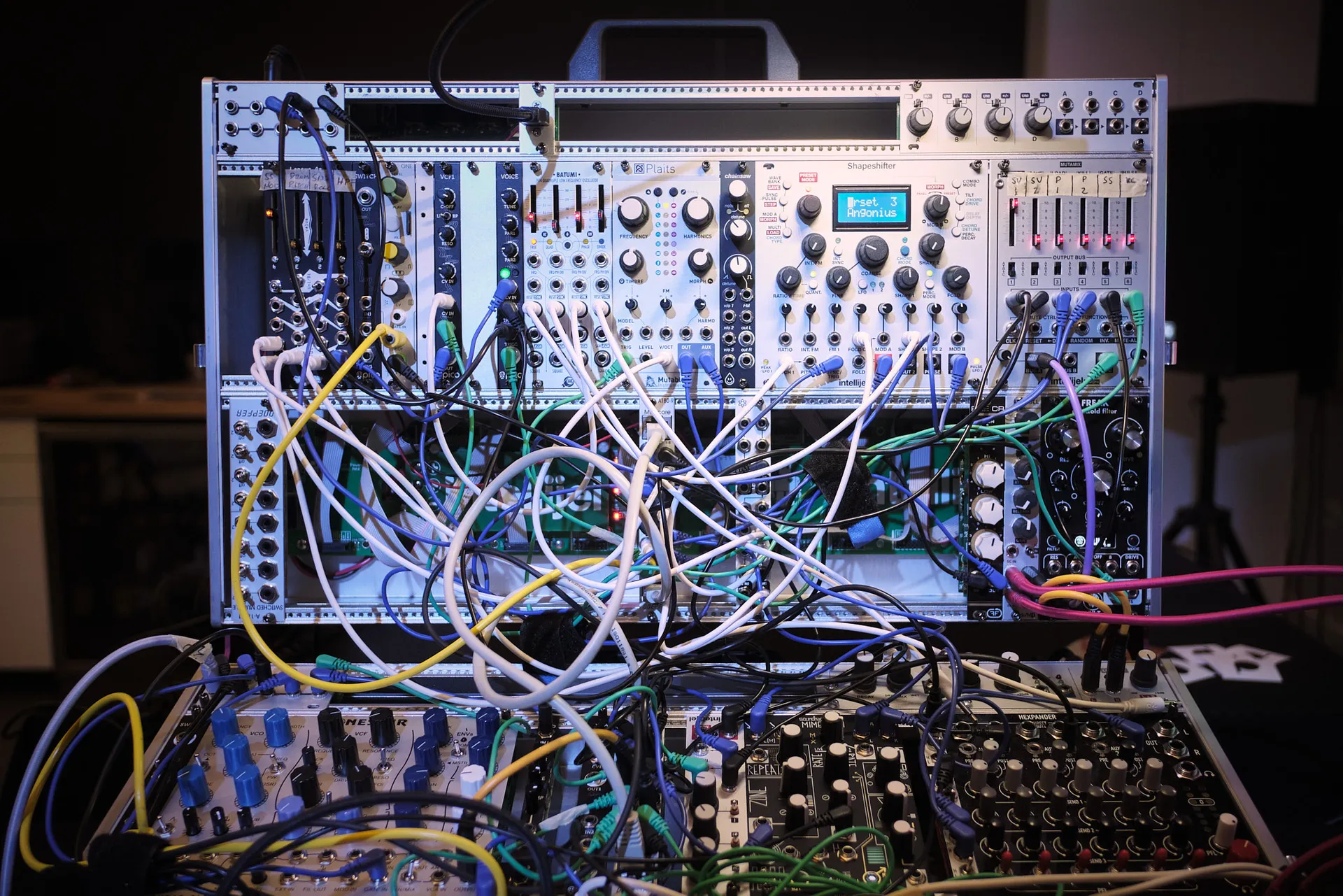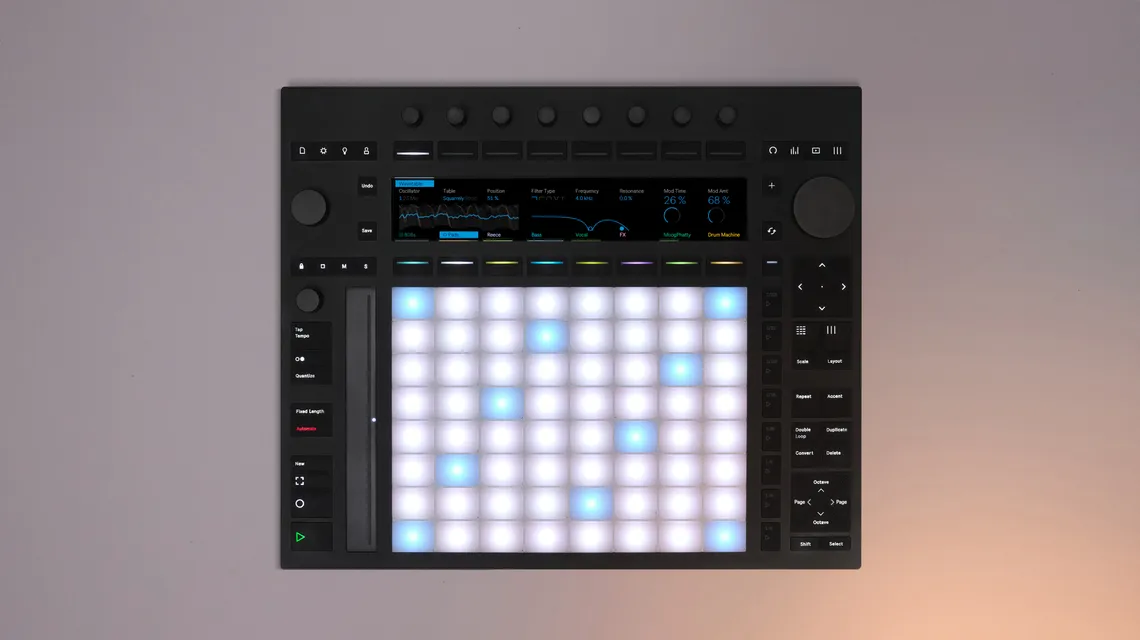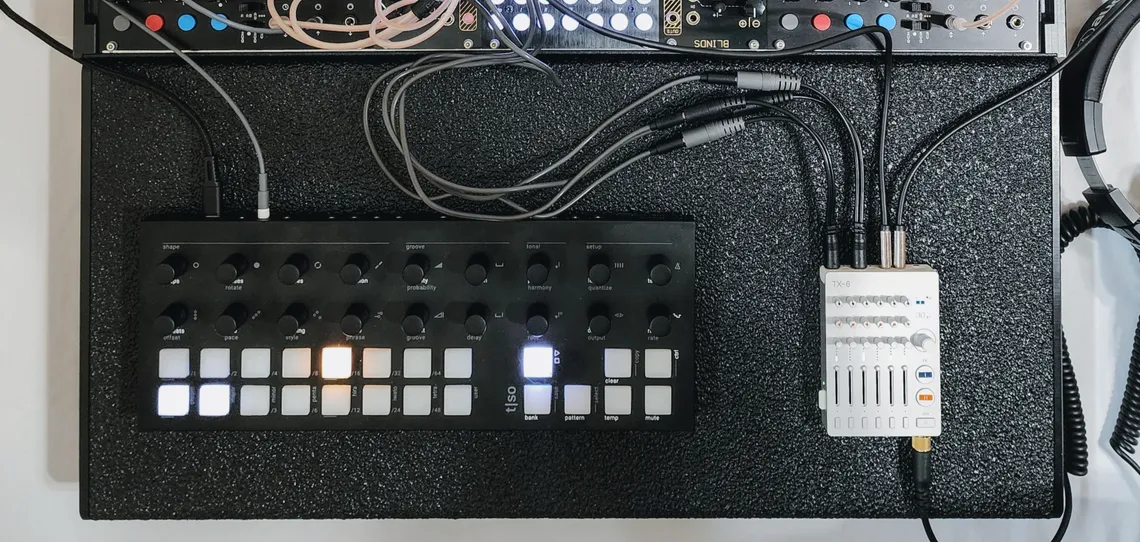Creating techno music on a modular synth is a deep dive into the expansive world of sound design. Techno can be very effectively explored with a modular synth due to its wide range of sound manipulation possibilities. This article will guide you through selecting specific modules geared towards techno and using them to create this genre's distinctive sound.
What a Eurorack modular synth setup for techno could look like
This is 104 HP split over two rows and packs a lot of power into a tiny case like the ALM-CS 6U powered Eurorack case.

Along the top we have a Kickain as the main kick with support for ducking included. Poly Cinematic for easy techno chord stabs or thick rolling basslines, and two Knit (6HP Plaits) for a "choose your own adventure" set of percussive voices among many others. The 16 input stereo spectral mixer by ALM, and the Messor stereo compressor should not be overlooked.
The bottom row is your control and effects section, starting with the Droid CV processor for all tasks such as sequencing, melody generation, slew limiting, quantizing, switching, mixing, working on clocks and triggers, creating envelopes and LFO or other fancy voltages. Next, the swiss army knife Expert Sleepers disting EX that will fill any void in a small focused case. Lastly, the multi effects GHOST from Endorphin.es in collaboration with Andrew Huang, a creative stereo effect processor with delay, reverb, filter, distortion, and quickly explorable routing chain with a single button press.
Let's explore further how we selected the modules in the above example.
Selecting percussion modules
A percussion section is an essential element of techno music, providing the rhythmic foundation and driving energy. In a modular synth setup, a dedicated percussion section can be created using drum modules, sequencers, and other utility modules for modulation and control.
Kickain from Knobula
Kickain, a combination of a virtual analogue kick drum and side chain compressor, simplifies and improves side chain workflow, yielding a cleaner, master-quality mix with a dominant kick drum.
TipTop Audio One
A sample-based drum module with a wide variety of sounds.
Noise Engineering Basimilus Iteritas Alter
A versatile drum synthesizer that can create kicks, snares, hi-hats, and more.
Mutable Instruments Grids
A drum pattern generator with three channels, optimized for techno and electronic music.
Erica Synths Pico Drums
A compact, sample-based drum module with 64 samples.
Sequencing a techno modular synth
A dedicated sequencer for your percussion section is essential for creating complex, evolving rhythms. Some sequencers to consider are:
Euclidean Circles
A sequencer based on the Euclidean algorithm, which generates complex polyrhythms.
ALM Busy Circuits Pamela's New Workout
A versatile clock source and sequencer with eight programmable outputs for triggering drums and modulation.
Varigate 4+
A four-track gate and CV sequencer that can create intricate patterns and randomize them on the fly.
Introducing complexity
The key to a techno performance is modulation and transition. Everything in your patch should be set up to change over time, and you should have the tools at your fingertips to control these changes and introduce new elements as your performance progresses.
Complex oscillators
These modules can generate a wider variety of tones than basic VCOs, often including built-in wave shaping and modulation options. This can be useful for creating the more abstract sounds often found in techno. Consider modules like the Mutable Instruments' Braids or the Make Noise STO.
Noise generators
Noise can play a big role in techno, adding texture and dissonance. Look for modules that can generate different types of noise, like white, pink, and brown. Mutable Instruments' Tides in noise mode is a great option.
Random/chaotic modulators
These can be used to introduce a level of unpredictability and dissonance to your sound. Consider modules like Mutable Instruments' Marbles or Make Noise Wogglebug.
Ring modulators/ frequency shifters
These can create complex, often atonal sounds from simple inputs, and can be a great tool for techno. Check out Doepfer A-114 Dual Ring Modulator or Mutable Instruments Warps.
Hands-on control
Hands-on control can significantly enhance your experience and performance while creating techno music on a modular synth, especially when it comes to techno, where the nuances can play a pivotal role in the overall soundscape. For a real world conversation about control, check out Piqued 10 where Korey and HEXMODE discuss the complexities of creating a bass drop with a modular synthesizer. Here are a few types of modules that you can consider for hands-on control:
Performance Mixers
Modules like the WMD Performance Mixer or the Befaco Hexmix provide a tactile interface for controlling the levels, panning, and effects sends of your different sound sources.
Manual Gates/Triggers
Modules like Doepfer's A-164-1 Manual Gate or Mutes from DivKid, can provide manual control over gates or triggers, allowing you to play your modular synth in a more performative way.
Touch Interfaces
Modules like Make Noise Pressure Points provide touch-sensitive pads that can be used to control various aspects of your sound. These can be used to control pitch, filter cutoff, effects mix, or any other parameter.
Joysticks/Expressive Controllers
Modules like the Doepfer A-174-1 Joystick Controller or the Intellijel Planar 2 can provide an X/Y interface for controlling multiple parameters at once, allowing for complex and expressive control.
Performing techno on your modular synth
Dynamic structure
Unlike a desktop synth or drum machine, a modular synth doesn't have preset patches or patterns. You're creating your sounds and patterns from scratch, which allows for a more dynamic and evolving performance. You can adjust parameters, reroute signal paths, and introduce new elements on the fly, which leads to a more organic, unique sound.
Complex tones
Use your complex oscillator and/or noise generator to create your main sound sources. Don't be afraid to use dissonant intervals, harsh waveforms, or other unconventional sounds. Use your ring modulator or frequency shifter to further process your sounds. This can create complex overtones and dissonant harmonics, adding interest to your sound.
Modulation
Techno is known for its slowly evolving, hypnotic soundscapes. Use your random/chaotic modulators to modulate various parameters of your sound sources. This could include pitch (for a constantly evolving melody), timbre (for a changing tone color), or amplitude (for a changing rhythm). Use your envelope generators, LFOs, and other modulation sources to change your sounds over time, slowly opening and closing filters, modulating pitches, or introducing rhythmic variation.
Effects
A modular synth allows for a more granular approach to sound design than a traditional synth or drum machine. Use your oscillator and effects modules to create dense, textural sounds, using techniques like granular synthesis, wavetable synthesis, and complex modulation. Consider connecting the output of your mixer to a master effects module, like a reverb or delay. This can help to glue your mix together and add a final layer of polish to your sound.
Sequencing
When sequencing your sounds, consider using irregular rhythms or changing your sequences over time. This can help to create the disorienting, hypnotic feel often found in techno.
Of course everyone will have their own way they approach a performance. Watch Trovarsi and cksample perform back to back modular techno sets at Piqued 27, and then discuss their sets with Korey.
Start experimenting
Remember, performing techno on a modular synth is not about replicating the exact sound of a desktop synth or drum machine. Instead, it's about embracing the modular environment's flexibility and unpredictability, so don't be afraid to experiment and push the boundaries of your sound. Remember, just because it's a modular synth doesn't mean it has to be random - a good techno track often has a deep sense of structure and progression, even if it's not the traditional structure you might be used to.





